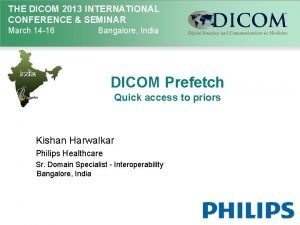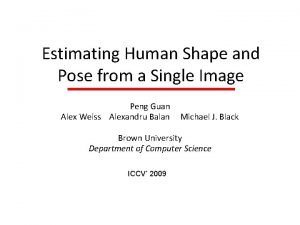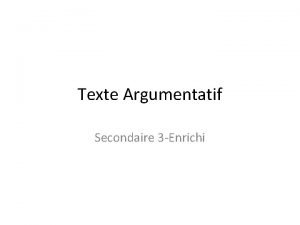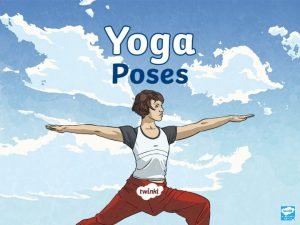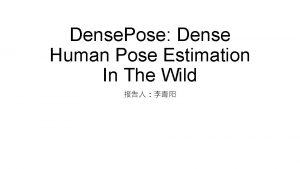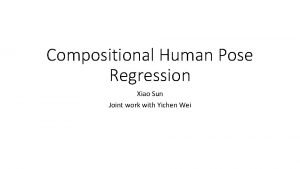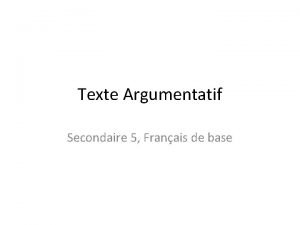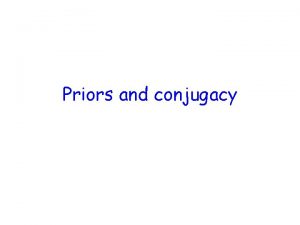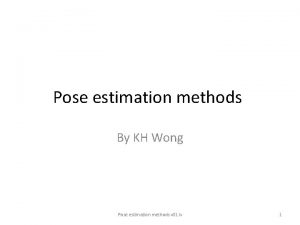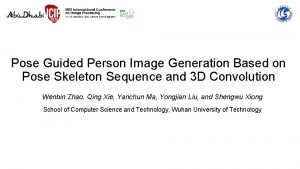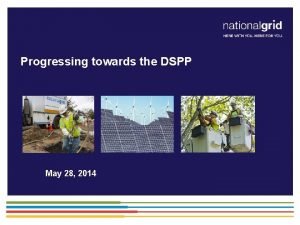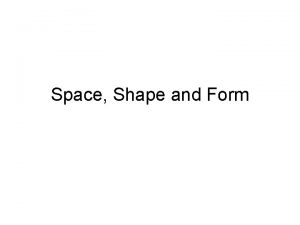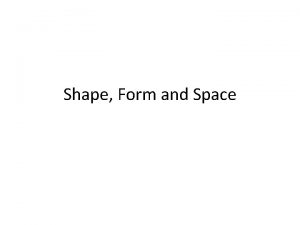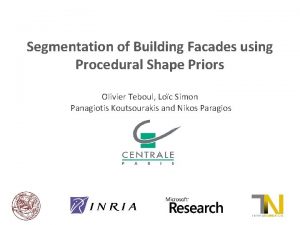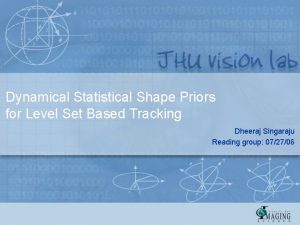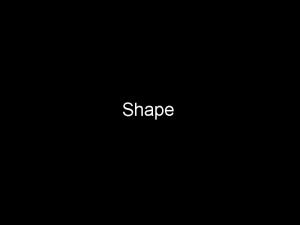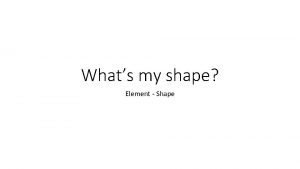DSPP Deep Shape and Pose Priors of Humans










![Training Datasets • MPII Human Shape Dataset [Pishchulin et al. 2017] • 4, 308 Training Datasets • MPII Human Shape Dataset [Pishchulin et al. 2017] • 4, 308](https://slidetodoc.com/presentation_image_h2/b2d74ae18c8ad87c795ce1c683f6abb3/image-11.jpg)





- Slides: 16

DSPP: Deep Shape and Pose Priors of Humans Shanfeng Hu shanfeng. hu@northumbria. ac. uk Department of Computer and Information Sciences Northumbria University Newcastle upon Tyne, UK Hubert P. H. Shum∗ hubert. shum@northumbria. ac. uk Department of Computer and Information Sciences Northumbria University Newcastle upon Tyne, UK Antonio Mucherino antonio. mucherino@irisa. fr IRISA University of Rennes 1 Rennes, France 1

Background and Motivation • 3 D virtual humans are essential in computer animations and games • However, scanning and capturing real humans are costly • Automatically synthesizing high-quality human shapes and poses becomes essential 2

Related Work • Linear Subspace Methods: [Blanz et al. 1999; Allen et al. 2003; Anguelov et al. 2005; Loper et al. 2015] • Assuming that the distributions of human shapes and poses are globally supported on a linear subspace • E. g. Using PCA to model the subspace • May generate unrealistic humans in low-probability area • Deep Learning Methods: [Habibie et al. 2017; Chen et al. 2017; Tan et al. 2018; Gokaslan et al. 2018; Kanazawa et al. 2018] • Learning the non-linear manifold of human shapes and poses • E. g. Variational Autoencoders (VAEs), Generative Adversarial Networks (GANs) • Directly sampling from the distribution to consistently create highquality random samples 3

Our Main Idea • Auto-encoding human shapes and poses into a low-dimensional space • Learning the manifold of human shapes and poses using GANs in this space • Known as Adversarial Autoencoders (Makhzani et al. 2016) traditionally used in image/video analysis • Instead of learning directly in the geometry (input/output) space as in previous work, our method learns in the low dimensional hidden (middle layers) space 4

System Framework – Shape Autoencoder Geometry Space (Reconstructed) Shape Decoder Low Dimensional Auto-encoder Space Shape Embedding Shape Encoder Geometry Space (Input) 5

System Framework – Shape GAN Geometry Space (Reconstructed) Shape Decoder Low Dimensional Auto-encoder Space Shape Discriminator Shape Embedding Shape Encoder Real/ Fake? Shape Generator Standard Normal Distribution Geometry Space (Input) 6

System Framework – Network Architecture Shape Decoder SN: Spectral Normalization Shape Real/ • Guaranteeing the discriminator to be a smooth Discriminator Fake? function • Much easier to train Shape Embedding Generator Re. LU PRe. LU Standard Rectified Parametric Rectified Normal Shape. Linear Encoder Unit Linear Unit Distribution 7

System Framework – Pose Autoencoder Geometry Space (Reconstructed) Pose Decoder Shape Decoder Low Dimensional Auto-encoder Space Shape Discriminator Shape Embedding Shape Encoder Real/ Fake? Shape Generator Pose Embedding Standard Normal Distribution Pose Encoder Geometry Space (Input) 8

System Framework – Pose GAN Geometry Space (Reconstructed) Pose Decoder Shape Decoder Low Dimensional Auto-encoder Space Shape Discriminator Shape Embedding Shape Encoder Real/ Fake? Shape Generator Pose Discriminator Pose Generator Standard Normal Distribution Pose Embedding Pose Encoder Geometry Space (Input) 9

System Framework – Network Architecture Pose Decoder Real/ Fake? Pose Discriminator Pose Generator Standard Normal Distribution Pose Embedding Pose Encoder 10
![Training Datasets MPII Human Shape Dataset Pishchulin et al 2017 4 308 Training Datasets • MPII Human Shape Dataset [Pishchulin et al. 2017] • 4, 308](https://slidetodoc.com/presentation_image_h2/b2d74ae18c8ad87c795ce1c683f6abb3/image-11.jpg)
Training Datasets • MPII Human Shape Dataset [Pishchulin et al. 2017] • 4, 308 human shapes • 6, 449 vertices for each shape • SFU Motion Capture Dataset [SFU 2016] • 100, 000 human poses, covering walking, running, dancing, and interactions • Each pose is represented using the 3 D Euler angles of 20 joints excluding the hips joint 11

Results – Training Losses • Consistent loss reduction • Easy to compress shape/pose into low dimensional without much loss Shape Reconstruction Loss (left) and GAN Loss (right) • The generator and the discriminator keeping on completing • No spiky loss • No one-side winning Pose Reconstruction Loss (left) and GAN Loss (right) 12

Results – Human Shape Samples Baseline: GAN in the geometry space Ours: GAN in the low-dimensional embedded space 13

Results – Human Pose Samples Baseline: GAN in the geometry space Ours: GAN in the low-dimensional embedded space 14

Conclusion and Future Work • We proposed to learn the manifold of human shapes and poses using GANs in the lowdimensional auto-encoding space • We open the source code and dataset • Future work • Joint modelling of distributions for both shape and pose • Correlating the bone length between shape and pose • Deforming the generated human shapes using the generated human poses • Quantitative metric to evaluate the realism of generated human samples (e. g. deep classifier to get a score) 15

Thanks! Any questions? 16
 Prefetching relevant priors
Prefetching relevant priors Priors wood school
Priors wood school Pose
Pose Deep asleep deep asleep it lies
Deep asleep deep asleep it lies Deep forest towards an alternative to deep neural networks
Deep forest towards an alternative to deep neural networks 深哉深哉耶穌的愛
深哉深哉耶穌的愛 Shape matching and object recognition using shape contexts
Shape matching and object recognition using shape contexts Shape matching and object recognition using shape contexts
Shape matching and object recognition using shape contexts Aerodynamic shape vs aerofoil shape
Aerodynamic shape vs aerofoil shape Alloprof introduction texte argumentatif
Alloprof introduction texte argumentatif Mountain pose benefits
Mountain pose benefits Densepose: dense human pose estimation in the wild
Densepose: dense human pose estimation in the wild Compositional human pose regression
Compositional human pose regression Exemple de texte argumentatif secondaire 5
Exemple de texte argumentatif secondaire 5 Purposeful questioning
Purposeful questioning Longue comme dix hommes un homme seul peut me porter
Longue comme dix hommes un homme seul peut me porter Sa1 pose
Sa1 pose
